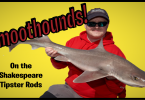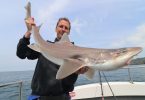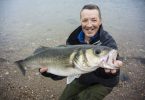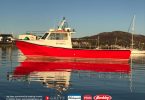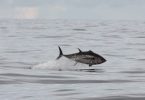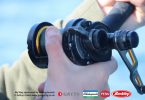Continued from https://www.anglersnet.co.uk/Sea-Fishing-Articles/mullet_faq_one.html
I’ve seen plenty of mullet feeding from a sewer-pipe, is that a good place to catch them?
Yes, if you’ve got a strong stomach and are willing to take the risk of catching something nasty!
If the sight of all those feeding mullet is too irresistible for you, please remember that you need to be extremely conscious of hygiene.
Don’t eat whilst you are fishing, and not after until you have washed you hands in clean water and soap.
Don’t bite your line, or hold it in your mouth whilst you sort out a tangle etc.
After a session at a sewer pipe, wash everything (putting your rods and reels under the shower is effective!).
The viruses and bacteria that come out with the sewage can easily become airborne, even on a calm day. More so if there’s a chop on the water, and more dangerously if the breeze is blowing from the sea toward you.
You won’t find me fishing at a sewer outfall!
How do you sex a live mullet?
I dunno!
The males and females have around the same growth rates, and grow to the same lengths, although the females do become fatter and heavier as their ovaries develop.
Do mullet feed after dark?
I’ve caught them after the sun has gone down.
Where do mullet go to in Winter?
Not being a species of great commercial interest, there has been very little research carried out on the seasonal movement of mullet.
It used to be assumed that they would migrate southwards once the weather grows colder, but I’ve heard from separate sources of shoals of mullet being encountered by divers in the winter, lying comatose in sheltered water, such as Chichester harbour (the diver was able to handle the fish, and to lay them on their side, leaving them laying there).
If they do indeed go into semi-hibernation in the winter months, that goes some way to explaining the very slow growth rate of fish around our islands (A 3lb fish is around 10 years old, whereas it will be around just 5 years old toward southern Europe).
Where the water is warmer, such as in the South-west, fish will stay and feed all year round.
NMC tagging effort has recorded fish tagged in the UK turning up off the French coast, so they do also move around, although this may have something to do with spawning migration (mullet first spawn around 10 years old, then only every other year, sometimes every third year).
When do mullet spawn?
Spring and early-Summer, with May being the peak month.
With the cod almost gone, do we need to be concerned about the future of our mullet fishing?
Yes, definitely.
Mullet take years to reach any size, and make up local populations. It doesn’t take too long for netsmen to wipe out a mullet sports fishery, especially removing most of the specimen sized fish that nature will not naturally replace for one or two decades.
Although mullet flesh doesn’t have a big market for human consumption, and therefore doesn’t command the high price of table species, when there’s not much else about netsmen will readily turn to them as a source of income, supplying the pot-bait and fish farm feed markets.
If we want to continue fishing for mullet, and specimen mullet, in the years to come, we each need to get more widely involved in marine conservation issues.
Political lobbying for the restoration of our cod stocks, giving the netsmen a more profitable target, will take the pressure off of commercial fishing for mullet, as much as campaigning for the conservation of the species directly, and for its recognition as an anglers sports fish.
Politicians, and economic planners, are at last waking up to the fact that angling for certain species is far more commercially important than unsustainably harvesting them for protein. And letters written by anglers are waking up the politicians to just how many votes could be at stake.
Joining together with others to protect and develop our Sea Angling heritage is almost essential if we are not to lose what we now have, or maybe even to make what we have now a distant memory of the low point of good fishing.
Consider joining:
The Sea Anglers’ Conservation Network (SACN) (It’s free!)
http://www.anglers-net.co.uk/sacn
The National Federation of Sea Anglers
How do I go about getting further information about mullet and mullet fishing?
Anyone interested in fishing for mullet should join the National Mullet Club. As well as lots of information in the club magazine and newsletters, the NMC organise regional fish-ins around the UK, a chance to meet experienced mullet anglers (they don’t bite!), learn new techniques and venues.
As a member, you’ll also have access to contact details of local mullet anglers, and regional mullet groups. They are always helpful towards new members and happy for the company of other local mulleteers, potential or experienced.
They also produce publications, and actively promote the conservation of the species.
Some other websites you might want to visit are:
https://www.anglersnet.co.uk Click on the ‘Articles’ button and look for articles from various authors with ‘mullet’ as the subject.
And some more articles on mullet fishing by Phil Whiting at:
http://web.ukonline.co.uk/aquarium/diary/chatham/chathamindex.html
http://web.ukonline.co.uk/aquarium/diary/jersey/index.html
You’ll find some further articles on mullet amongst the various articles written by me at: https://www.anglersnet.co.uk/authors/introleon.htm
This video is worth buying:
http://www.beekay.force9.co.uk/videos/crp074.htm
There’s useful information to be gleaned by looking through the archived newsletters of the Medway Mullet Group at: https://www.anglersnet.co.uk/medway
For information about conservation visit the Sea Anglers’ Conservation Network (SACN) website at: https://www.anglersnet.co.uk/sacn
And the National Federation of Sea Anglers (NFSA) website at: http://www.nfsa.org.uk
Leon Roskilly
ps I am indebted to the articles written by Donovan Kelley, and to the many contributors to Grey Ghost (the NMC magazine), which are a source of insights into the biology and habits of mullet and how to catch them.


